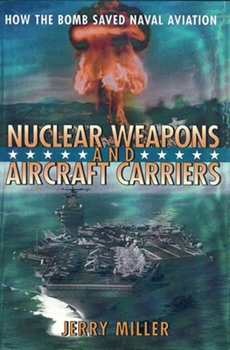Nuclear Weapons and Aircraft Carriers: How the Bomb Saved Naval Aviation
The U.S. Navy entered World War II with seven aircraft carriers and finished the war with nearly one hundred. However, with the advent of the atomic bomb in 1945 and its impact on strategic thinking, the future of naval aviation looked bleak. Rapid demobilization after the war eliminated many carriers, and most policy makers believed that future wars would be fought with nuclear weapons delivered by land-based aircraft, a method patented by the new...
Format:Hardcover
Language:English
ISBN:1560989440
ISBN13:9781560989448
Release Date:April 2001
Publisher:Smithsonian Institution Scholarly Press
Length:296 Pages
Weight:1.50 lbs.
Dimensions:0.9" x 6.3" x 9.3"
Customer Reviews
2 ratings
No Limits for Today's Postnuclear Aircraft Carrier
Published by Thriftbooks.com User , 23 years ago
At a time when the efficacy, utility, and survivability of the big-deck aircraft carrier and its multimission air wing are being challenged anew by armchair strategists and "inside-the-Beltway" analysts, retired Vice Adm. Gerald E. "Jerry" Miller has contributed an important perspective on how the Navy's post-World War II push to develop an aircraft and aircraft carrier capable of delivering a nuclear bomb paved the way for the design of the most effective and versatile platform for seaborne aviation in the world today--the Nimitz-class nuclear-powered aircraft carrier. Miller documents each step along the way in an informative, narrative style for what might otherwise be an arcane and overly technical treatise on engineering-and-aeronautical design. He turns back the pages of history more than 50 years to the day that then-Cdr. Frederick Lincoln "..." Ashworth reported to Los Alamos, New Mexico, in 1944 to serve on the Manhattan Project then developing the first nuclear bomb. The need to document the story of the Navy's struggle to develop its post-war nuclear mission began with Miller's dialogue with Ashworth-himself a veteran combat aviator in the Pacific War.The personalities, aircraft, ships, tactics, and targeting policies associated with the Navy's Cold War mission are all well-represented, including the famous "Revolt of the Admirals" that saw respected naval leaders like Adm. Arthur W. Radford, then-Capt. Arleigh A. Burke, and others risk their careers to argue for a new role for the Navy in transporting, targeting, and delivering nuclear weapons. Miller writes with a familiarity and authority forged by many years of command at sea during a distinguished 38-year career that included surface combat in a cruiser during World War II, command of a fighter squadron during the Korean War, and command of a carrier division during the Vietnam War. His experiences as the commander of both the U.S. Second and Sixth Fleets during the 1970s and, later, as the deputy director of the Joint Strategic Target Planning Staff provide the reader with fresh insights into the traditionally highly classified story of how U.S. nuclear weapons were targeted during the height of the Cold War. In 1991, President George Bush announced that all nuclear weapons would be removed from Navy ships and submarines. Naval aviation's more than four-decade association with nuclear weapons came to an end. But, as Miller writes, "The prenuclear carriers had a questionable future. The postnuclear carriers appear to have no limit."As an aviator who had the privilege to serve as the officer in charge of Miller's helicopter detachment during his tour as commander of the U.S. Sixth Fleet, I found it exhilarating to relive some vintage examples of Jerry Miller's dynamic leadership, energy, and vision on the pages of his first book on naval aviation. A second is said to be in the works. The legions of Jerry Miller fans around the world can only hope that more will follow. Gordon
Gripping Insider's View of Evolution of U.S. Naval Aviation
Published by Thriftbooks.com User , 23 years ago
This well-researched account of the sobering impact of nuclear weapons development and procurement on the evolution of the U.S. military establishment is a must read for historians, defense contractors, aviators, officer candidates, weapons developers, lobbyists, and appropriations policymakers alike. The author provides a balanced view of the men, issues, and machines involved in building the most sophisticated hardware, training, and operations systems ever conceived for delivery of the world's most powerful weapons. The depiction of inter-service and intra-service rivalries during this period (1945-present) is skillfully presented with the very words of the participants. Not simply an historical account, the experienced insider's view of the author (VAdm. Gerald E. Miller) provides a no-nonsense perspective on how decisions were made in the past with implications for the future. Reading this book is like reading Aviation Week & Space Technology magazine and wondering if our potential adversaries are learning more from it than we are ourselves. This book is a credit to the Smithsonian Institute Press - I hope to see more books of its caliber in the future.




